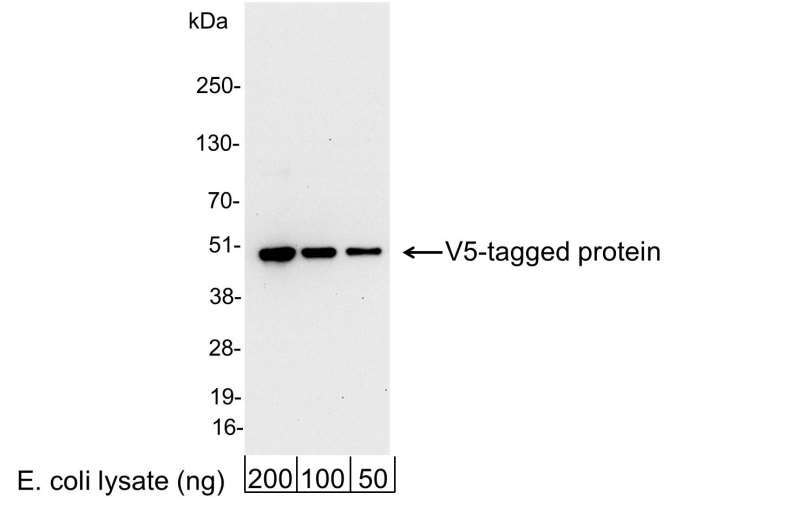Anti-V5 Tag [Polyclonal]
Data
 Detection of V5-tagged Protein by western blot. Samples: 200, 100, or 50 ng of E. coli whole cell lysate expressing a multi-tag fusion protein. Antibodies: Affinity purified, goat anti-V5 antibody 18868 used for WB at 0.04 µg/ml (1:25,000). Detection: Chemiluminescence with an exposure time of 30 seconds.
Detection of V5-tagged Protein by western blot. Samples: 200, 100, or 50 ng of E. coli whole cell lysate expressing a multi-tag fusion protein. Antibodies: Affinity purified, goat anti-V5 antibody 18868 used for WB at 0.04 µg/ml (1:25,000). Detection: Chemiluminescence with an exposure time of 30 seconds. - -
- -
Antibody DetailsProduct DetailsHost Species Goat Immunogen Synthetic peptide corresponding to aa 95-108 (GKPIPNPLLGLDST) of RNA polymerase alpha subunit of simian virus 5 conjugated to KLH. Product Concentration 1.0 mg/ml Formulation Phosphate Buffered Saline (PBS) containing 0.09% Sodium Azide State of Matter Liquid Product Preparation Purified by peptide immuno-affinity chromatography Storage and Handling This antibody is stable for at least one (1) year at 2-8°C. Country of Origin USA Shipping Next Day 2-8°C Applications and Recommended Usage? Quality Tested by Leinco Immunoblotting: use at a dilution of 1:1,000- 1:20,000.
Immunocytochemistry: use at a dilution of 1:100-1:400. Immunoprecipitation: use 1-4ug/mg lysate. ELISA: for detection use at a dilution of 1:1,000-1:30,000; for coating use at a dilution of 1:100-1:500 These are recommended dilutions. Endusers should determine optimal dilutions for their applications. Each investigator should determine their own optimal working dilution for specific applications. See directions on lot specific datasheets, as information may periodically change. DescriptionSpecificity Goat Polyclonal Antibody specific to V5. Antibody was affinity-purified on the peptide. Background The V5 epitope tag is a short, 14-amino acid peptide with the sequence GKPIPNPLLGLDST, originally derived from the RNA polymerase α subunit of simian parainfluenza virus 5 (SV5). Widely used in molecular biology and protein expression studies, the V5 tag enables efficient detection, purification, and localization of recombinant proteins. Due to its compact size, the V5 tag is less likely to disrupt the structure or function of the fusion protein, making it ideal for a variety of applications including Western blotting, immunoprecipitation (IP), and immunofluorescence or confocal microscopy. V5-tagged constructs are commonly used when antibody specificity, sensitivity, and minimal interference with native protein activity are critical. Antigen DetailsResearch Area Epitope Tags References & CitationsTechnical Protocols |
 Products are for research use only. Not for use in diagnostic or therapeutic procedures.
Products are for research use only. Not for use in diagnostic or therapeutic procedures.


